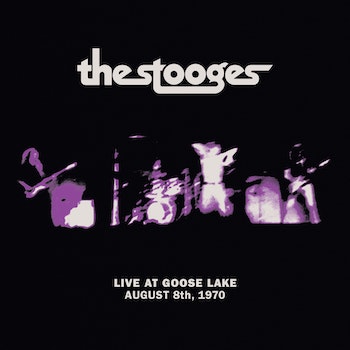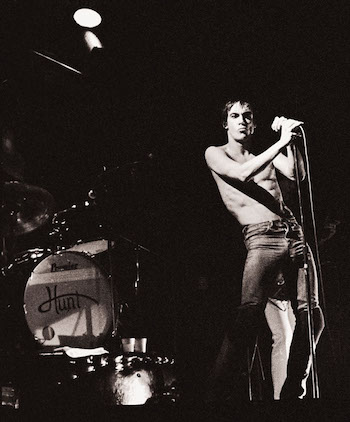Rock Album: 1970’s “Live at Goose Lake” — The Stooges Hitting Their Feral Stride
By Matt Hanson
If we factor in the triple-size oversell crowd, the bad drugs circulating, and the home field advantage, there was plenty there to inspire The Stooges to raise some merry hell.

By 1970, The Stooges were as tight a unit as they’d ever been. Having come from the bleak, industrial Michigan underground they’d already made a name for themselves with provocative live shows and gone all the way to New York City to record their self-titled debut record with none other than the legendary John Cale. The just released Fun House beat the so-called sophomore slump a lot of interesting bands go through — after all, you get your whole life to make your first record but not your second. The album served up a raw, squirming, fierce set of blood-curdlingly charismatic rock and roll. For my money, Raw Power, highlighted by its untouchable opener “Search and Destroy,” is their greatest achievement. Fun House was what paved the way for that triumph and, by 1970, The Stooges were only starting to hit their feral stride.
No less a luminary than Jack White, himself a Stooges fanatic, has released a bootleg, The Stooges: Live at Goose Lake, August 8th, 1970, via his venerable Third Man Records label and it captures the group in all their glory as a matchless live act. Goose Lake was an outdoor festival which featured a Detroit garage rock version of Woodstock, which included hometown heroes MC5 and Bob Seger. So, if we factor in the triple-size oversell crowd, the bad drugs circulating, and the home field advantage, there was plenty there to inspire the band to raise some merry hell.
Goose Lake was the biggest gig the band had ever had at that point. Yet the performance had previously gone down in infamy due to the probably ill-advised intoxication of each of the band members, which Iggy has blamed on the bass player’s supposed irresponsibility. Sadly, Dave Alexander was booted shortly thereafter, thus ending the original lineup. Luckily for us, the band soon added ace axeman James Williamson, which gave them that little extra horsepower they hadn’t exactly lacked but certainly gave them a new and crucial sonic weapon.
According to the extensive notes from Creem Magazine’s Jaan Uhelski, Iggy was particularly frazzled onstage from the various technical (and chemical) inconsistencies, which is certainly understandable given that the lead singer is always going to catch the flack for most of whatever goes wrong. Listening now, however, with the benefit of the superb soundboard’s recording of every instrument, every one of those primal, seductive grooves comes through crystal clear, even the bass grooves.
We open with the swaggering “Loose” which combines the propulsive surge of the guitar and drum synchronization into an exultantly raunchy ditty about getting, well, loose. Then it’s a quick, tight transition to the militant march of “Down In The Street” as if they were really just one whole song after all. Critic Lester Bangs, who adored The Stooges, wrote a classic essay putting the band in their proper historical context and once compared its opening riff to the sound of the boots of a street gang strutting down an alley. Henry Rollins once riffed amusingly about how potent the song still was many years later, and how trying to outdo Iggy live is a fool’s errand even for a punk veteran like himself.

Iggy Pop, October 25, 1977 at the State Theatre, Minneapolis, MN. Photo: Wiki Commons
The line that Iggy blurts — “NO WALLS!” — apparently caused a bit of a disturbance after the show. The venue’s security detail arrived at the Stooges’ lair and began working them over about whether that line meant that the band was inciting a riot. The assumed reference was to the barricades that separated the stage from the audience. Iggy and crew eventually saved the day by pointing out that the line was always in the song. Harassing musicians just ain’t right. Still, getting a whiff of the raucous way Iggy howls that line, you at least can understand the concern.
“1970” and the title track proffer the same ferocity as the album versions, with the added edge that live bootlegs can deliver. You can hear the audience cheering the band on, even from a distance. The drums are a clatter of metal, the Ashton brothers provide a sinuous rhythm section, and you can just picture scrawny, indominable Iggy thrashing away as he whoops and hollers up a storm over the avant-garde caterwaul of Steve McKay’s sax, which appears in the later numbers. That addition of a horn section was a clever and under explored connection between garage rock and free jazz, which The Stooges utilized whenever they saw fit to go experimental. This live version of the set closer, “L.A. Blues,” is actually much steadier and more groove-based than the official album version, which degenerates into a primordial soup of squawks and yelps and dissonance and roiling sonic murk. Let Stooges obsessives — and there many, given the loving and exhaustive treatment Rhino records recently gave Fun House — debate which is the mightier cut.
Make no mistake, Goose Lake is a recording that was unearthed from a Michigan basement where it had been languishing for decades. There are plenty of dead spots, random scratches, and times when things get a bit wobbly in terms of the compact, sparse song arrangements. But so what? That’s rawk and roll for ya. Symmetry and proportion aren’t necessary. And this lively testament proves that nobody, or very few, ever served up prime cuts of that glorious noise better than The Stooges in their prime.
Matt Hanson is a contributing editor at the Arts Fuse whose work has also appeared in American Interest, Baffler, Guardian, Millions, New Yorker, Smart Set, and elsewhere. A longtime resident of Boston, he now lives in New Orleans.
Tagged: Goose Lake, Live at Goose Lake, Matt Hanson, The Stooges

That’s rawk and roll for ya. Touche.